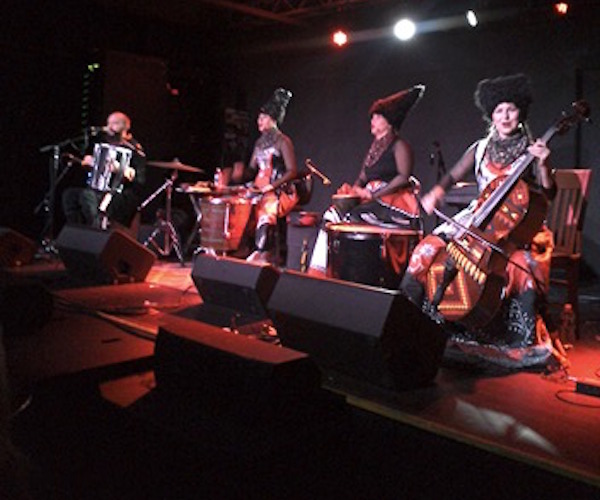Concert Review: DakhaBrakha — Music of Ecstatic Energy
The members of DakhaBrakha have created something uniquely their own — “folk-punk.”

DakhaBrakha at Brighton Music Hall. Photo: Mignon Ariel King.
By Mark Hänser
DakhaBrakha means “give/take” in Old Slavonic, and for an hour and a half on Saturday, November 18 at a SRO show (presented by World Music/CRASH arts) at Brighton Music Hall that’s just what this Ukrainian quartet musically did — in a matter of speaking.
Visually, the four band members are strikingly visual: Marko Halanevych on vocals, djembe (a Malian goblet drum), tabla, digeridoo, harmonica, and accordion; Olena Tsybulska on vocals and percussion; Iryna Kovalenko on vocals, djembe, flute, buhay (a conical Ukrainian drum), piano, and ukulele; and Nina Harenetska on vocals, cello, and standing bass. The group’s flair for drama is understandable, given that DakhaBrakha started out as a project of the avant-garde Ukrainian theater Dakh (“dakh” means “roof” in Ukrainian). With their towering, black lamb’s wool hats and crimson beads and other finery, the performers dramatic appearance complement their aural ear-print — one part singing villagers, another part urban avant-gardists. The band takes its own rich ethnic musical heritage, then borrows from Arabic, Indian, indigenous Australian, and other Slavic cultures, and transforms the mix into something uniquely their own — “folk-punk.”
They began their set with a number called “Karpatskyi,” in which polyphonic singing was followed by drums, both continuously interweaving with each other. It was an auspicious beginning. Alas, your reviewer was unable to discern the names of most of the other numbers, but no matter: listening to the concert was like following an ever-cresting wave. Accordion and cello opened the next song, the tempos changing from mournful to hopeful, ending on a wallop of almost doo-wop joy. The vocal blend generated by DakhaBrakha resembles that of Le Mystères Des Voix Bulgares (which I previously reviewed), but it is not as diaphanous as the latter. This was earthy, carnal stuff. Next, Nina switched to standing bass, Olena to ukulele, and Marko produced a rainstick. Soon the vocals turned to birdlike calls and avian sounds as the number moved into an insistent railroad groove. A lengthy story-song followed. Marko produced a jaw’s harp and announced “folk art poetry!” The percussion began to interplay with the swirl of voices and Olena declared, with a sigh, “Girl tries to find a husband . . . long story!” Somehow bluesy notes and Slavic scat singing found their way into the vigorous mix.
Nina’s cello droned on hauntingly as the other members sang and drummed on the last two numbers, including the high-energy closer, “Yelena.” If this was the entertainment for a village on the steppe, all of the area’s inhabitants would be dancing. The encore, “Baby,” was flat out fantastic, a tune driven by piano and harmonica and, curiously enough, Brill Building-style harmonies, with Marko singing out “show me the light!” Much deserved applause followed; the band left the stage holding a satin eggshell blue and canary yellow Ukrainian flag.
Mark Hänser is a visual and performing artist, poet and writer, actor and musician, and educator. Mark has a BA in History from California State University Long Beach, where he majored in Medieval and Renaissance Studies; a BFA in Painting and Interrelated Media, with a minor in Art History, from Massachusetts College Of Art And Design; and an Ed.M in Arts In Education from Harvard University. He has written and edited for a number of publications, including the Boston Phoenix, where he wrote about music.
Mark has taught art in a number of Boston-area arts programs, and taught drama for a semester at the Cambridge Friends School. He really enjoys donuts.

